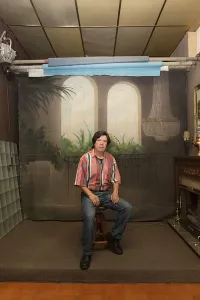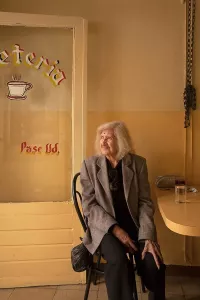Being. Being a human. Being a worn out photograph. Being a mold on a wall corner. Being is underestimated.
Whatever exists in the now has a limited contingency, whether it's our body, our clothes, where we live, the dogs on the street or the cracks in the pavement. Anything conjugated in the present tense has persisted through time. It's ironic how the nowness is so difficult to live in, the tendency to longing yesterday and the anxious craving for tomorrow, and yet, the now is the past and future itself. The proof of battle for existence and the possibility of a continuance in time.
Persistence can be as strong as the will of a sticker hanging on a lamppost and as tough as the survival of cavern art. A great mexican photographer, Melba Arellano, takes us on a frank trail down Mexican persistence. Inhabiting not just urban characters but spaces, lamps, curtains, workshops, hand-painted signs and elevators. Her photographic work on her series The persistence of the Margins tracks the rough spots of the passing of time. A subtle representation of the ongoing gentrification process of Mexico City, expressed in what is current, alive and present, resisting to disappearance but slowly fading.

Arellano captures the evidence of an urban mutation that falls to all levels of tangibility, from houses and livelihoods to offices and small businesses, passing through business cards and maps to memories and regrets, and the owners of all of them. Gentrification is mostly coined as urban or infrastructural transformation, but it digs deeper into what is considered valuable, profitable or wasteful. It transforms the value systems of perceptions and in a sad end of story, washes away cultural construction and living history. Is true that nothing is forever and change is inevitable, but the stick-to-it·ive·ness is also part of that unavoidable equation.
Every resistance has its own nuance, it may seem as evil as the idea of slavery, lofty; as many religions may address themselves or novelettish as the belief of the one and only true love. All persistence knights, tangible or intangible. always proceed from a place of security or forgiveness. Continuance comes from attachment; to an idea, a building, a piece of fabric, an epoch or a wallet photograph. A tailor man may resist the big corporate fashion system with a little tailoring workshop, because it secures a living, it secures the idea of being useful, of the appropriation of a profession or craft that has turned into a lifestyle. Everything we attach to gives us a sense of security, something we can hold on to when times change.
Melba shows us the different layers of an economic persistence, of those margins that were crucial in their times, and now seem to be a side effect of a never ending process of a constant, but not always adequate, progress. Those providers of goods and services search for survival on an economic market that seems profit as a synonym of new, polished, standardized and strictly controlled. There lies the importance of those who resist, not on a simple whim or pure baseless obstinacy, but the ones with strong convictions about their own identities and ways of living.

What resists is what becomes historic. What battles time and forgiveness is what constitutes knowledge and culture. History is there to remind us not to make the same mistakes, the past is not just for contemplation, but for examination. A lot has been learned about history and still, most times the historic value is set aside and diminished towards the notion of current utility. That is also the place where the act of photography nurtures life and its documentation. Providing a sense of transcendence to those whose persistence will sooner or later deplete.
Arellano opens up a visual discussion, like the one millennials before would have been tormenting Heraclitus and Parmenides. What is meant to change and what is destined to permanence. Humans have been acting as gods playing with contingency and choosing what they think is worthy of surviving, but power dynamics have always benefited the ideas of those higher on the pyramid of social status, or madness.
Those willing to resist are defying that paradigm, enriching the economic, cultural and social landscape of their own hometown. The time will come when progress would not mean vanish but adequation, in the meantime we are left on the shoulders of the knights of persistence, to remind economic structures of the value of living culture.




